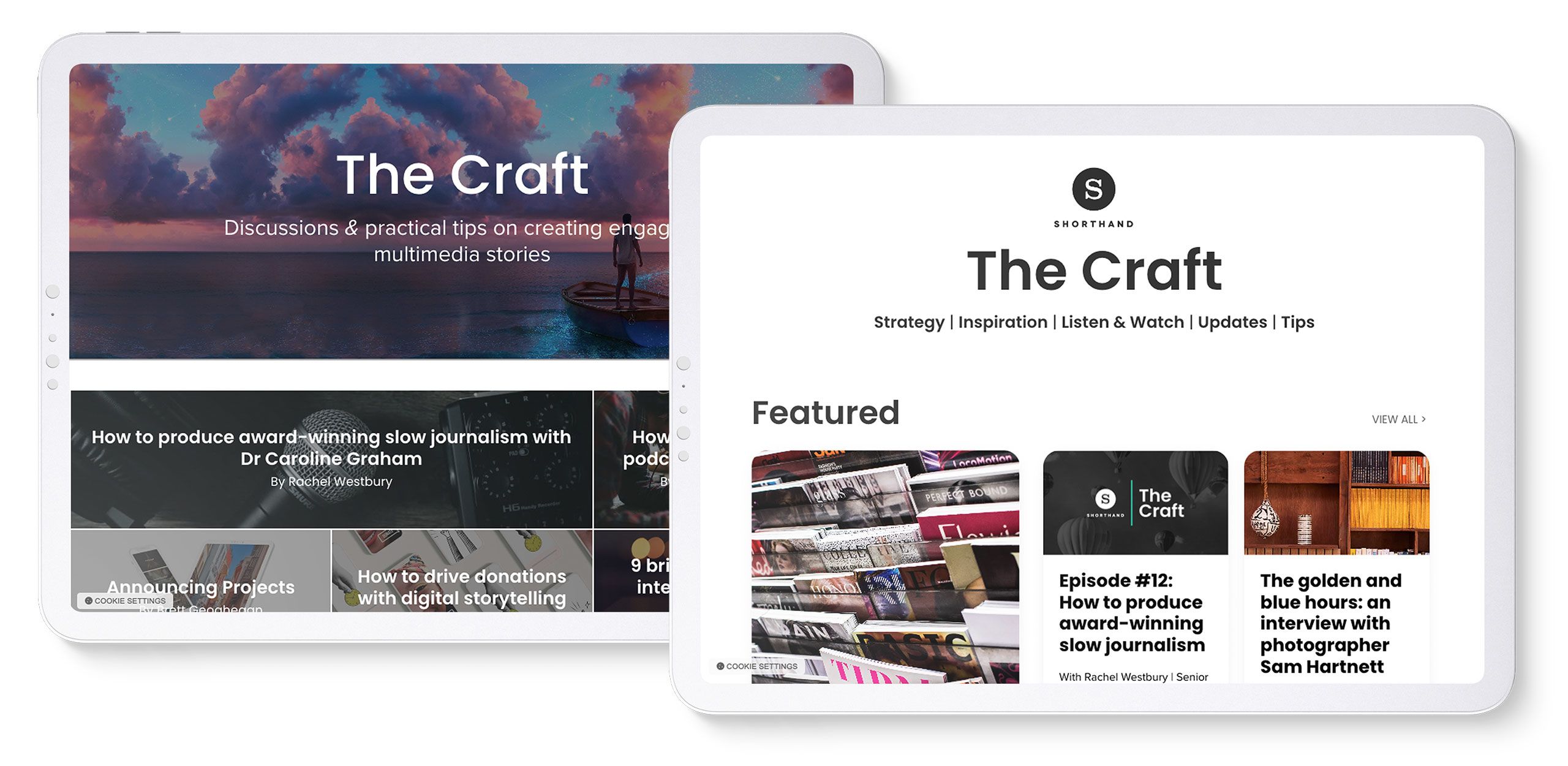Why Shorthand killed its blog — and why you should, too

We killed our blog because it was getting in the way of us doing our best work. This is a symbolic act, but an important one.
Too often, blogs are where writers and designers do the worst creative work of their professional lives. No one, after all, expects great things from a blog. No one even expects good things. It’s ‘just a blog.’
As I’ll argue in this piece, decisions around genre matter more than we think. Genre gives us form. It gives us conventions to follow. Most importantly, genre sets expectations — for our readers and our writers and designers.
The blog is a broken genre. What other profession feels so dismally about its core output, as so many content professionals do? What would it take for us to feel genuinely proud of our work? And how does better content fit into a mental model still dominated by traffic, funnels, and conversions?
Let’s scratch the surface of these questions — and also pour one out for Shorthand’s trusty blog. The Craft blog is dead; long live The Craft magazine.1
I’ll cover:
- The Craft's very typical back story
- Why blogs make it hard to build an audience
- Why blogs encourage weak editorial decisions
- Why brand and reputation are so important
- The massive untapped potential on most content teams
- Our plans for The Craft magazine
- Did we really need to make The Craft a magazine?
- Why you should, too
What do the BBC, Tripadvisor, and Penguin have in common?
They craft stunning, interactive web content with Shorthand. And so can you! Create your first story for free — no code or web design skills required.
Sign up now.
Our back story
The Craft was born as a sub-brand for Shorthand’s content marketing. As with most blogs, posts to The Craft were published in reverse-chronological order. That is, the most recent posts — regardless of quality or purpose — appeared at the top.
This made some sense at the time. Shorthand was a much smaller company when The Craft was launched, and there were much bigger content-fish to fry. Or, to switch metaphors, we had to build the content engine before deciding where we wanted it to go.
Over the last two years, we’ve put a lot of work into building and tuning this content engine. We have great writers, great designers, and a repeatable process. We’ve even had some successes, especially in SEO. As I wrote about earlier, we’re following a well-worn trail.
But I’ve come to think that it’s a trail that leads, inevitably, to a dead end.
Why do I think this? And more to the point, why mess with something that is, by most measures, relatively successful?
We want to build an audience
Let me answer that question with a question. Who intentionally reads an organisation’s blog? The answer — no sensible person — is curious, given how much money is spent creating them.
Most blogs, particularly in tech, are created on the assumption that building a recurring audience is basically impossible. You can get people to your website by writing algorithm-friendly content (via search, for example). But you can’t get them to visit intentionally, no matter what.
There’s a curiously circular logic to this. When starting out, most blogs are largely dependent on algorithms to distribute content. This algorithmic-horse inevitably ends up leading the content-cart. Editorial decisions are watered down for Google, leading to the sorts of uninspiring copycat content that fills most blogs.
As a rule, SEO-driven content will almost never generate a loyal, recurring audience. And without an audience, we’re back where we started: relying on algorithms for distribution!
Is there another way? I think so, but it requires taking a larger view of your marketing channels. While we can’t expect folks to check Shorthand’s blog 12 times a day — the way some maniacs (totally not me) check their local news site — we can build distribution channels that aren’t dependent on algorithms.
As it happens, Shorthand already has these channels. We have a newsletter with a healthy five-figure subscriber base. We also have a community coming very soon. Crucially, we also have the in-house editorial talent to produce and commission great content.
But I don’t think we have a large, recurring audience. Not yet. What will it take to get there?
We want to make better editorial decisions
We have subscribers and great creative talent. We’re bloody brimming with potential. But without a framework to make stronger editorial decisions, this potential has been wasted.
I personally find it very difficult to make rigorous editorial decisions for a blog. I’ve managed blogs for nonprofits and SaaS companies for ten years, and I’m still not clear what a ‘blog’ is outside an empty container for ‘content on the website.’
This is partially a feature, not a bug. One of the great benefits of blogs is that they can be filled with all sorts of content stuff. Event announcements, product updates, fundraising celebrations, SEO'd guides, missives from the CEO — the blog can be a container for all of it.
Usually, this means that the company can avoid making any sort of editorial decisions whatsoever. When you’re really small, this might actually seem like a blessing, as it means one less decision you have to make.
But let’s be honest: no media company would subject its audience to such a hodgepodge of content as is found on most blogs. No media company would think more about what it can publish than what its audience wants to read. The only reason so many companies get away with it is because, as mentioned above, most blogs don’t have an audience in the first place.
Again, genre matters. It gives us form, conventions, and a mental model. It sets expectations.
I think we need to work within more ambitious forms, conventions, and mental models. And we definitely need to set higher expectations.
On that note 👇
We want to build a stronger reputation
In an age of funnels and detailed attribution models, most content marketers spend relatively little time thinking about brand. Most are incentivised to drive conversions that can be easily attributed to a specific piece of content. This is because conversions are the easiest way to report on the impact of content to the executive team.
For the most part, this model is responsible for the blog content we experience on the modern web. And it’s easy to see why. Content marketers need to be able to connect their work with whatever outcomes their organisation wants (usually revenue).
The problem is that this produces terrible incentives for the creative team producing the content. Instead of focusing on how to educate and delight a real human — a human with much higher standards than is typically acknowledged — creative teams focus on optimising a funnel. That means getting lots of people in through SEO and other inbound tactics, and then ‘converting’ a small percentage through to the next stage.
In this model, some of the fundamental principles of brand marketing – and, frankly, effective human communication — are quickly tossed aside. Few content marketers consider the emotional response of their reader, even though this emotion is a basic prerequisite to someone remembering a brand over the medium term.
At Shorthand, we want to build a stronger brand reputation; and reputation, after all, is nothing more than memory at scale. This memory of a brand is what drives future purchasing decisions and word of mouth. And word of mouth is a much more reliable driver of growth (whatever your growth metrics are) than conversions from SEO’d content.
We want to realise the potential of our team
Can you name a writer or designer who publishes the best work of their lives on a blog? It’s a strange question — an unintentionally funny one, maybe.
For me, the category of ‘blog post’ has long felt like an anachronism. Blogs were a big deal in the early 2000s. The best blogs had a point of view, a loyal audience, and were a genuine participant in public debate.
Those days are long gone. Most blogs were killed off with the arrival of social networks, which quickly captured the lion’s share of online attention. Bloggers moved their content away from their own websites to Twitter and Facebook. Aside from real-time commentary of live events, blogs don’t serve much of a purpose anymore.
Now, the blog feels like a zombie content type, shuffling along in the dusty reaches of corporate websites — little more than an archive of Google-friendly content — while the rest of the world moves (even further) on.
In practice, this means that the expectations for blog posts are incredibly low. If you looked around the world’s corporate blogs, you would think that they were a magnet for the most bland, uninspired writers.
I don’t personally think there’s much truth to that. If you look at the side projects of almost any content marketer, you’ll find an extraordinary track record of creative and intellectual work. But this talent isn’t at all manifest in most blogs.
What would it take for companies to truly leverage the enormous talent that sits on their content teams? What do we need to do to achieve that?
The Craft is a magazine
As of 30 November, 2022, The Craft is a magazine.
On the surface, this is an underwhelming decision, with underwhelming implications. It’s not the radical departure in design and scope announced by those infamous blog killers, Intercom. We don’t have their strategy; frankly, we do not have have their budget.
Instead of a reverse-chronological feed, we’ll arrange our content according to five different verticals: content strategy, video, inspiration, Shorthand updates, and tips on writing and design.
Alongside our historic SEO’d content lane, we’ll be looking to add more content journalism, as well as and opinionated content (like what you’re reading!).
We have launched the Master the Craft community, and we’ll continue to improve our popular newsletter, which rounds up the best content on the web.
Let’s be clear: we’re not there yet. Anyone who dives into the archives of The Craft will see that we’re only just getting started. Prior to killing the blog, we regularly published SEO-driven content, alongside news and updates from the Shorthand team. We think it’s pretty good stuff, but it isn't indicative of where we want to be.
Why we chose a magazine
Could these changes have been made while continuing to call The Craft a blog? Perhaps. But as I’ve hinted at throughout this piece, genre matters. It sets expectations for everyone involved — and critically, the writers and designers doing the work in the first place.
Magazines, by definition, have stricter editorial processes. They have a defined audience. They are an umbrella for a broad range of content types. They care deeply about brand and design. And they always want to delight their readers.
Magazines also give us different role models. Unlike blogs, the world and history of magazines — in both their hard copy and digital incarnations — is full of exceptionally rich and impressive creative work. By turning our attention to them, instead of the latest Silicon Valley tech company, we’ll be inspired to different kinds of work. And I think our readers will be better off as a result.
In killing our blog, we set out to gradually undo the worst practices of content marketing. By founding a magazine, we embrace the best practices of writers and designers on the web (such as Shorthand’s own impressive customers).
Why you should, too
Let me close with a chilling anecdote. John Bonini, Director of Marketing at Databox, likes to periodically quote an anonymous exec.
Like a well-known exec told me last year: “We have a lot of content ranking on page1, I just hope no one sees it.”
John (if I can call him that) presumably shares this quote reasonably often because it gets a strong reaction.
But the nature of this reaction is worth noting. People aren’t shocked or horrified at this oddball outlier. In fact, they’re not surprised at all. They’re agreeing with him. They’ve seen it themselves in high-ranking, poorly-written blogs across the web. It’s normal.
How did we get here as a profession? If the blog is broken, and the blog is the primary output of content marketing, then maybe something in the profession of content marketing is broken, too.
As I’ve mentioned again and again in this piece, the problem isn’t one of talent. Content marketing is full of amazing writers and designers slumming it in their 9–5s. The problem is definitely one of incentives. The problem is also one of strategy and reporting.
I also think that these problems are fundamentally ones of genre. It’s a long bow to draw, I know. Am I right? Watch this space and see what we produce. Whatever we do, we won’t be embarrassed to share it. We might even be a little proud.
Notes
1. Quick hat tip to John Collins and the 2018 team at Intercom, who published the original confessional, ‘We killed the blog.’ They even conclude their post with an almost identical sentence to this one (a total coincidence, I promise). I came across this piece embarrassingly late in the drafting process — and I’m glad I did. Its argument for killing the blog is much more positive than mine. It argues that a publication will allow Intercom to address a broader audience, and provide it with greater flexibility in editorial decision making and design. This is all true, but isn’t the core reason we made our decision at Shorthand.



